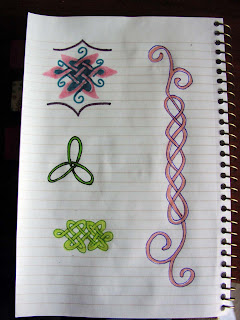I know, you're thinking, "Does such a thing exist?"
Today is St. Patrick's Day! Time to wear some green, get pinched if you don't, and watch some parades.
Oh, yeah, and it's also a day to celebrate and remember the holy life of this missionary saint. Have you read his beautiful prayer yet?
I saw this video a few days ago (in a roundabout way it is thanks to a blog commenter). Some very fancy mathematical thingamabob called graph theory makes simple Celtic knotwork extremely easy. I just had to share! And what better day than the Feast of St. Patrick? :)
Those of you who have said, "Wow, Celtic knotwork looks cool, but way to hard for me" (which would be everyone who said anything)-- you now have no excuse. :)
You, like me, are about to be captivated by the beautiful art of drawing Celtic knotwork... without the tangles of headaches.
This video is by Vi Hart, a "recreational mathemusician." You might have to watch the video a few times, because shetalksasfastasIdowhenIgetexcited (translates to: she talks as fast as I do when I get excited.)
Basically, all you have to do is draw a random squiggle-- but make sure each loop is obvious and that the ends are either connected or very obviously seperate.
Next, use that squiggle as a guideline to make the "over-under" pattern.
One very neat thing-- when using this method, any direction that you go and any amount of branchings that you take always make a perfect "over-under" pattern, assuming you are starting off of one point.
I'm sure that there is a mathematical reason for that, but I just think it's neat.
Now, finish drawing your knot and "decorate it."
 |
| TaDa! Super easy, what did I tell you? |
You can use Sharpies, markers, pencils...
And if you have a very thick marker, it's even easier to draw the knot. Just make your squiggle-rope with one swish of the marker, and then trace the over-under pattern.
Now, there are some obvious limitations to this technique. The main problem is that freehand drawings of such geometric patterns always turn out somehwhat lopsided. As long as it takes, grids and compasses are useful.
Also, using a scribble like this makes it neigh impossible to draw more complicated knots. You can only use one strand (or a couple if you are talented), and if you want a structured look with no spaghetti, you have to be able to visualize it beforehand. For complicated patterns or spaces, the grid method is better-- as much as I detest grids!
If you are really getting into knotwork, please check out the post where I share my favorite (beginner) tutorials.
But why am I going on about the limitations? The "scribble method" is so easy! I highly doubt you Fairy People are as insane as I am. You probably don't care much about complicated knotwork. You probably aren't writing your next English paper on the history of Celtic knotwork.

 |
| Don't ask. The left page is true spagetti knotwork, and the right is what I do when I am bored... |
___________
I love Vi Hart's videos. I wish all math could be taught this way. I would learn so much more! This reminds me of non-Eucledian geometry... I liked it because M.C. Escher did a really neat drawing with it that got me interested.
Seriously... I don't like numbers-- I prefer shapes and finding the little patterns in things (but only after I know the big picture-- I'm all right brained like that, and the rest of my family doesn't understand me). This is why I loved geometry (except for the proofs) and detest Alegbra II with vehemence.
Here are a few more of her Math Doodle videos:
This is seriously cool. I love these ideas... math can be neat. (I did not just say that.)
Hehe. Check out this video that's a bit of a spinoff of Vi Hart's. Very funny for the camel/needle joke. Bit more math than I can follow at bullet speed, though.
Hehe. Check out this video that's a bit of a spinoff of Vi Hart's. Very funny for the camel/needle joke. Bit more math than I can follow at bullet speed, though.
Does this remind anyone of M.C. Escher? Here he combined tessellations and the hyperbolic plane.
| image source |
Random fact: Did you know that the hyperbolic plane can be make out of crochet? It's the only medium that works...
Wow-- art, math, and Greek mythology? This girl isn't a mathemusican but a mathemagician. (Yes, I think I'm punny).
This is as of two weeks ago: "Let's say you're in math class. You're supposed to be learning about exponential functions, but you're having trouble caring about exponential functions."
I still don't care about exponential functions-- at least when logarithms and other bizzare things are concerned-- but do you know what? This visual description of exponential growth is both fun and makes much more sense than a graph with an asymptote.
Now go check out Vi Hart's website. She does many random artsy-mathsy things.
Since I'm on the topic of artsy-things, I thought I'd share this link with you. A very nice set of articles. A friend of mine (curse you, Perry the Platypus! *cough* I mean "Sir Humnus") made me spend an entire week pondering dimensions and tesseracts and whatnot. Seriously, he gave me one link and managed to take over my mind. I had a strange dream concerning a box that is a nail suddenly appearing in the middle of my room... Oh, and read the book Flatland. I got it free on my iPod. It's like... extreme awesomeness.
I wish math classes could be taught like this!!!
...okay. This post went on a LONG tangent. :)
(edit: I did a video about drawing celtic knots here!)




